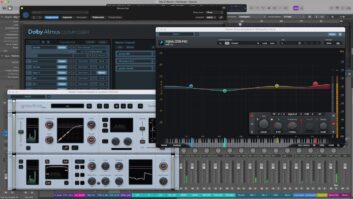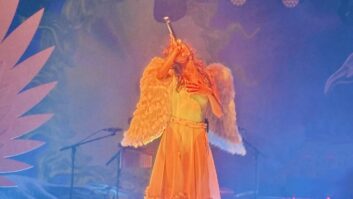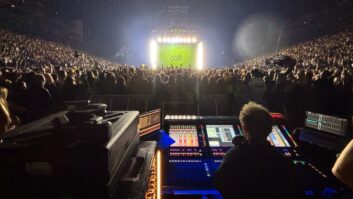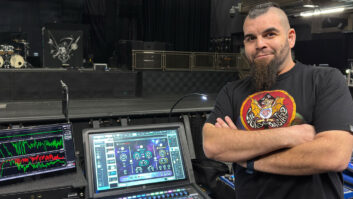ANAHEIM, CA—The touchscreen is firmly entrenched as a pro audio user interface (UI), along with stalwart mid-twentieth century knobs, faders and buttons, plus mouse and track ball/pads from the first digital revolution. Modern workflows increasingly follow consumer technology for time- and money-saving reasons, and the touchscreen is the latest example: Look no further than Winter NAMM 2015 and multiple new touchscreen mix systems unveiled by the biggest names in the biz.
Alex Oana, co-creator of the Slate Raven: “What is important is having creative interaction with your audio that feels fulfilling. It gets you the results you want and the process is enjoyale.” Pictured, the Slate Pro Audio Raven MTx with 46-inch multi-touch LED screen. Credit this to the zeitgeist of creative tech in 2015, as touchscreen mixing is certainly no new idea. An AudioMedia US Edition news story from the turn of the millennium announced that SoCal TV/film mixing studio 4 Media Co.’s Stephen Anderson had unveiled “The Glass Console” and built two 128- and 96-“fader” models— intriguing, if at least a decade early.

“Of course, the most influential is the iPhone, then iPad; that’s influenced everybody,” offers Alex Oana, co-creator of the Raven, Slate Pro Audio’s DAW GUI, the first multi-touch audio production system, unveiled in 2012.
“I can’t pretend that in the Raven, we created a touchscreen to interact with a DAW,” Oana continues. “People came out of the woodwork with stories about other attempts at touch control—like The Glass Console. It was a concept and technology slightly ahead of its time. The Raven takes advantage of a nexus of available technology in the hardware domain with touchscreens and an ability to conceptually integrate touch technology as a third party. Without the direct cooperation of DAW platform makers, our approach had to be to use existing protocols—both communication protocol to communicate with the DAW and protocol for the host computer’s OS. We really used every trick in the book to hack our way into creating tools that did what we wanted them to do. Up to that point, it seemed impossible based on the restraints those protocols seemed to create.”
Arguably, 2012’s Raven sparked measurable touchscreen initiatives amongst historically mixer-focused manufacturers. “Within a year, we saw a response,” recalls Oana. “For example, SSL placed a DAW right in the center of Duality, a big analog console, in a workstation approach. Neve, with Genesys Black, placed a DAW right in the center of a hybrid analog/digital console—a touchscreen allowing a single-touch on the DAW, but quite basic compared to what the Raven can do. Steven [Slate] and I iterated on ideas, and if Slate were a bigger company to execute all the ideas we had at the time? Well, we had an idea on the drawing board for exactly what one manufacturer is doing now with its live touchscreen console.”
“We’ll probably hit a point, as the new generation of engineers come up that are comfortable with them, where you’ll see the majority shift over to touchscreens,” predicts Ray Tantzen, senior product manager for digital mixers at PreSonus, currently shipping the StudioLive RM 32Ai 32-channel touchscreen mixer running UC-Surface multi-touch control software. “Though I don’t think we’ll ever see physical faders completely go away.”
Like Mackie’s DL Series mixers, UC-Surface systems are optimized for iOS and iPad, though the RM Series comes out of the gate with Windows 8-enabled live touch potential at Ravenesque dimensions; for example, Sweetwater now offers an RM Series bundle that includes a 19.5-inch Lenovo HORIZON 2e 10-point multi-touch PC ($650 street, separately) running Win 8.1 OS.
“We’re lucky with Apple and the iPad for the quality and interaction we have,” continues Tantzen. “The Windows 8 touchscreen computer was a new thing for us. We started off buying a few [CPUs] from different manufacturers to see what we liked and didn’t. I was really surprised by the multi-touch capabilities of Windows 8; it was pretty consistent across computers. You do have the challenge of different screen resolutions and how you design your software to be compatible across different resolutions. With the iPad, there are only a couple of resolutions to deal with, though it’s grown over the past few years with the mini, Retina displays, and so on.”
As for supporting other operating systems, like Android, “the breadth of different devices that run on that platform with different resolutions, screen sizes and performance of the processors is a challenge,” poses Tantzen. “Because Windows 8 has been solid, we just recommend minimum system requirements. We’ll follow suit as we look at Android, too—follow or it’s a ‘we can’t guarantee your results’ deal.”
Serious tech hurdles remain for optimized touchscreen mixing, admits Oana. “The idea that our infinite world of the DAW is confined to 1,920 horizontal pixels by 1,080 vertical pixels is just so limiting. The display itself has so much room to grow and evolve. Pixel real estate is crowded. The other missing part can happen now: more intelligently designed UIs. Interacting with an infinite world one mouse-click at a time is a most frustrating creative experience. The Raven applying a touchscreen approach to those beautiful graphic interfaces is a first step. What allows a more human expression? With the Raven, the best features are the simplest. Can I touch a plug-in? Yes. Can I touch more than one fader at a time, so I’m more than a mouse pointer? Yes. Within this touchscreen world, you can more easily express yourself artistically.”
For others, the most appealing feature of touchscreen mixing will be the tablet’s promise of mobility and ease. “The touchscreen is a means to an end, and that end is wireless mixing,” emphasizes Ben Olswang, senior product manager at Mackie. “We allow you to have a very small, portable Wi-Fi interface in your hand and a range of I/O. Once you go down the touchscreen road, its other benefits allow you to grow in scale, and change, and improve things over time. The DL1608 is now in its third version; we’ve added features that we could’ve never added to a hardware mixer. Our UI has grown over time because we have this blank slate to work with.”







